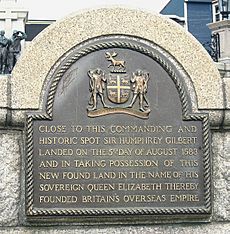History of Newfoundland and Labrador facts for kids
The province of Newfoundland and Labrador has a long history. It goes back thousands of years to the first people who lived there, all the way to today.
Before Europeans arrived, different groups of Indigenous peoples lived in what is now Newfoundland and Labrador for a very long time. The first Europeans to briefly visit were the Vikings around 1000 AD. They settled for a short time at L'Anse aux Meadows. Later, in 1497, explorers and fishermen from England, Portugal, Spain, France, and Holland began exploring the area. Fishing trips happened every season. The first small permanent settlements started around 1630.
Newfoundland became an independent dominion in 1907. But its economy struggled in the 1930s. So, in 1934, it was governed by a special group called the Newfoundland Commission of Government. Things got better during the Second World War. After much discussion, the people voted to join Canada in 1948. Newfoundland officially became part of Canada in 1949.
Even after joining Canada, poverty and people moving away were big issues. However, over the last half of the 20th century, old tensions between different groups faded. A new feeling of being a united Newfoundland emerged through songs and popular culture. In the 1990s, the province was hit hard when the cod fishing industry suddenly collapsed. But in the 2000s, interest in the oil industry grew, which helped the province's economy.
Contents
Early History of Newfoundland and Labrador
Human life in Newfoundland and Labrador began about 9,000 years ago with the Maritime Archaic people. Over time, other groups like the Dorset Culture, Thule, and finally the Innu and Inuit in Labrador, and the Beothuks on Newfoundland, came to live there.
First European Explorers
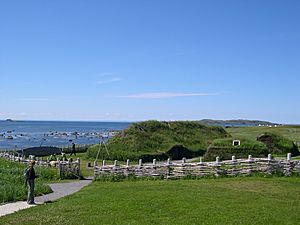
The first Europeans to reach North America were the Norse settlers. They came from Greenland around 1000 AD. For several years, they lived in a village at L'Anse aux Meadows on the tip of the Great Northern Peninsula. You can still see remains and artifacts from their time there. L'Anse aux Meadows is now a World Heritage Site. The island was also home to the Beothuks and later the Mi'kmaq people.
From the late 1400s, European explorers like John Cabot and Jacques Cartier began exploring the area.
European Fishing Trips
Fishing boats from Spain (especially Basques), England, Portugal, France, and Holland started making seasonal trips to Newfoundland. Basque ships had been fishing for cod off Newfoundland's coasts since the early 1500s. They used the natural harbor at Placentia. French fishermen also began using the area.
In 1578, a man named Anthony Parkhurst reported on the European fishing activity. He said that the English fleet had 50 ships, the Spanish had 100, the Portuguese 50, and the French/Bretons 150. The Basques also had 20-30 ships just for whaling.
Newfoundland Becomes a Colony
John Cabot, sent by King Henry VII of England, landed on the northeast coast of North America in 1497. The exact spot is not known, but the 500th anniversary was celebrated in Bonavista.
Sir Humphrey Gilbert landed in St. John's in August 1583. He officially claimed the island for England.
17th and 18th Centuries
In 1610, John Guy from Bristol started 'The London and Bristol Company for the Plantation of Newfoundland'. He set up a settlement at Cuper's Cove and became its governor. Other early settlements included Bristol's Hope and Avalon. Sir David Kirke became the first governor with power over all of Newfoundland in 1638.
From the 1770s, missionaries and settlers in Labrador learned to live with the harsh winters and thin soil. They experimented with gardening and managed to grow tough vegetables to stay healthy and rely less on imported food.
Fishing Industry
Explorers soon realized that the waters around Newfoundland had the best fishing in the North Atlantic. By 1620, 300 fishing boats were working the Grand Bank, employing about 10,000 sailors. Many were French or Basques. They dried and salted the cod on the coast and sold it to Spain and Portugal.
A system called the "admiral" system was used before 1700. The first captain to arrive in a bay would decide where others could cure their fish. This system changed after 1700. Fishermen started leaving crewmen behind to claim the best spots. This led to "bye-boat" fishing, where local small-boat crews fished in the summer and sold their catches. This helped create a more permanent population on the island. The fishing admiral system ended in 1729 when the Royal Navy took over governing during the fishing season.
International Conflicts
In 1655, France appointed a governor at Plaisance (now Placentia), starting French colonization in Newfoundland. In 1697, during the Avalon Peninsula Campaign, Pierre Le Moyne d'Iberville almost took over English settlements. But the French failed to hold onto their gains. French colonization ended with the War of the Spanish Succession in 1713. In the Treaty of Utrecht, France gave up its claims to Newfoundland to the British.
In the Seven Years' War (1756–63), control of Newfoundland's valuable fishery caused conflict between Britain, France, and Spain. In 1762, a French force landed in Newfoundland and took over parts of the island, including St. John's. But their plans to conquer the island ended when they were defeated at the Battle of Signal Hill.
The Treaty of Utrecht (1713) gave French fishermen the right to land and cure fish on the "French Shore" on the western coast. They had a base on nearby St. Pierre and Miquelon islands. France gave up these rights in 1904. In 1783, the British signed the Treaty of Paris with the United States. This gave American fishermen similar rights along the coast.
19th Century Developments
Newfoundland got its own local assembly, called the House of Assembly, in 1832. This happened after a push by reformers like William Carson. Carson argued for a resident governor and an elected legislature instead of rule by naval commanders. His efforts helped Newfoundland become a colony in 1824 and get an elected assembly in 1832.
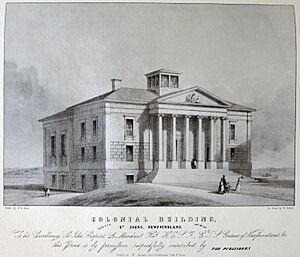
In 1855, Newfoundland gained "responsible government." This meant the elected assembly had the final say, not the royal governor. The Liberal Party, supported by Irish Catholics, and the Conservatives, supported by merchants and Protestants, took turns in power. In 1869, Newfoundlanders voted against joining the new country of Canada.
In 1861, a political crisis happened. The Protestant governor removed Catholic Liberals from office. The election that followed was chaotic. To calm things down, the new Conservative Prime Minister, Hugh Hoyles, worked to share power. Jobs and positions were split among different religious groups. This "denominational compromise" also extended to education. All religious schools received government funding. This made politics less about religion and more about economic issues.
By the 1890s, Newfoundland had rejected joining Canada again in the 1869 election. Sir Robert Bond was a Newfoundland nationalist. He believed the colony should be equal to Canada and opposed joining. Bond supported building a railway across the island to access minerals and timber. This would reduce the island's heavy reliance on cod fishing. He also wanted closer economic ties with the United States.
Economy in the 19th Century
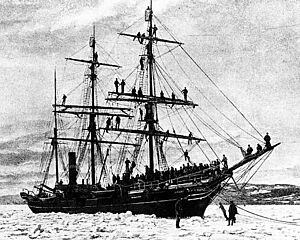
In the 1850s, new local banks provided credit, replacing the old system where merchants gave credit. Good times brought more people, especially Catholics from Ireland, who soon made up 40% of the population. Small-scale farming became common. Mines began to open, extracting lead, copper, zinc, iron, and coal. Railways started in the 1880s, with the line from St. John's to Port aux Basques opening in 1898.
Seal hunting off the coast of Labrador became a small industry in the late 1700s. It started with nets and traps. Then, sailing ships were used around 1800. After 1863, steam-powered ships, which were more powerful and reliable, took over.
20th Century Changes
At the start of the 20th century, the population of St. John's, the capital, had doubled. In 1901, the religious census showed many Roman Catholics, Church of England members, and Methodists.
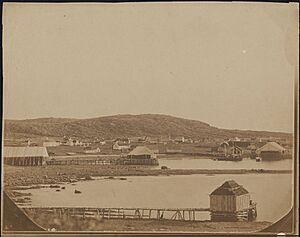
In 1904, as part of an agreement between Britain and France, France gave up its fishing rights on the "French Shore" of Newfoundland. This had been a right since 1713. Also, the ownership of Labrador was debated between Quebec and Newfoundland until 1927. That year, a British court decided the boundary, giving Newfoundland control over a larger area of Labrador.
In 1905, the public education budget for Newfoundland was $196,000. It supported 783 schools with over 35,000 students. About 25% of the population, mostly older people, could not read or write. The school system was divided by religion until the 1990s.
Newfoundland Becomes a Dominion
Newfoundland became a dominion on September 26, 1907, similar to New Zealand. This meant it was a self-governing part of the British Empire. It tried to make a trade agreement with the United States, but the British government stopped it after Canada objected.
The Dominion of Newfoundland had a good period under Prime Minister Sir Robert Bond. However, his efforts to limit American fishing rights failed. This led to his party losing badly in the 1909 election. Bond then formed a partnership with the new Fishermen's Protective Union (FPU), led by William Coaker. The FPU aimed to help fishermen earn more money by breaking the merchants' control over buying and selling fish. It grew to over 21,000 members.

Edward Morris became premier after Bond. Morris started building more railways and handled a dispute over American fishing rights. He also introduced old-age pensions and invested more in education. He was reelected in 1913. Morris later formed an all-party government in 1917 to manage the war effort. He retired that year and moved to London.
First World War Impact
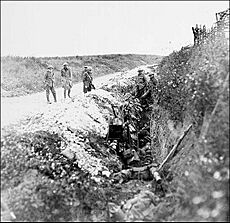
Newfoundland strongly supported the First World War. Many men joined the Newfoundland Regiment for overseas duty, the Royal Navy, and the Forestry Corps. Women also became war nurses. Premier Morris and the governor created the Newfoundland Patriotic Association to oversee the war effort.
During the terrible Battle of the Somme in France in 1916, the 800-man Royal Newfoundland Regiment attacked German trenches. Most of the Newfoundlanders were killed or wounded without firing a shot. This sacrifice became a powerful story for the province. Memorials were built, and the story inspired people.
Between the Wars (1919–1934)
In 1919, the FPU joined with the Liberal Party to form the Liberal Reform Party. They won the 1919 election.
The 1920 Education Act created a Department of Education to oversee all schools. International companies became interested in Newfoundland's natural resources. A Canadian company opened iron mines in 1895. British companies built paper mills and opened a lead-zinc mine. In 1927, Britain officially gave the vast area of Labrador to Newfoundland, adding valuable new resources.
Politically, the years from 1916 to 1925 were difficult. Many governments failed, and there was corruption. The good times after the war ended, and the economy struggled.
Newfoundland Commission of Government
Newfoundland's economy crashed during the Great Depression. People lost trust in politicians. This led to Newfoundland giving up its self-government. It is the only country that has ever willingly given up its democracy.
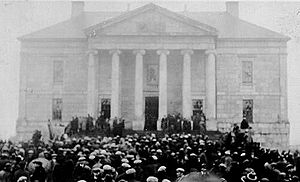
Economic Hardship
The Great Depression caused Newfoundland's economy to collapse. Prices for fish, its main export, dropped sharply. The population was 290,000, and many people had no money. Since there was little farming, people relied on government relief and help from friends and family. While no one starved, many people suffered from poor nutrition.
Political Changes
The government was broke. It had borrowed a lot of money to build a railway and pay for its soldiers in the First World War. By 1933, the public debt was over $100 million, much more than the country's income. The government couldn't get any more credit. The government led by Richard Squires was ineffective, and he lost power when he was arrested for bribery in 1932.
A special group called the Newfoundland Royal Commission, led by Lord Amulree, looked into the financial problems. They found that the government had spent too much money and had no savings. They recommended that Britain take control of Newfoundland's finances. Newfoundland would give up self-government. Instead, it would be run by an appointed governor and a six-member Commission of Government. This was meant to give the country "a rest from politics" and a government free of corruption. The legislature agreed to this plan. In 1934, the Commission of Government took control, and it lasted until 1949.
Second World War and Prosperity
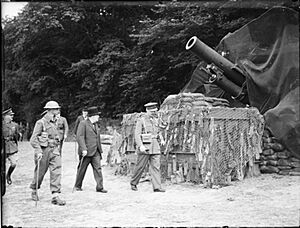
In 1940, Winston Churchill and Franklin D. Roosevelt agreed to a deal. The United States would get access to British naval bases, including in Newfoundland, in exchange for destroyers. This brought sudden wealth to the island. American money poured in, and about 20,000 men found jobs building military bases. The cost of living rose, but American ideas about food, hygiene, entertainment, and living standards greatly influenced the island. Newfoundland became very important for protecting convoys in the Battle of the Atlantic.
After the War
After the war, America kept and expanded its bases in Newfoundland. This was because the island was on the shortest air route between the Soviet Union and the East Coast of the United States. These American bases were important for Newfoundland's economy. Many Americans also married local residents.
Canada worried that an independent Newfoundland might join the United States because of their strong economic and military ties. Canada wanted to prevent this. Newfoundlanders had regained their wealth and confidence. But they were unsure if they should be an independent nation with close ties to the United States, or become part of Canada.
The Referendum
When prosperity returned during the war, people started asking for the Commission of Government to end. Newfoundland, with about 313,000 people, seemed too small to be independent. Joey Smallwood was a well-known radio personality and writer who had long criticized British rule. In 1945, London announced that a special convention would be elected to decide what choices should be put to a public vote. Joining the United States was a possibility, but Britain removed that option. Instead, they offered two choices: return to dominion status or continue the unpopular Commission. Canada worked with Britain to make sure the US option was not on the ballot.

Canada offered to let Newfoundland join on generous financial terms. Smallwood was elected to the convention. He became the main supporter of joining Canada. He argued that Newfoundlanders deserved the same living standards as Canadians. Smallwood used clever tactics to get the Canada option on the ballot. His main opponents were Peter John Cashin and Chesley Crosbie. Cashin warned against cheap Canadian imports and high Canadian income tax. Crosbie wanted self-government first, then closer ties with the United States.
Smallwood's side won in two votes in June–July 1948. Joining Canada defeated becoming an independent dominion. The vote was 78,323 (52.3%) for Canada and 71,334 (47.7%) for independence. Strong support from rural areas for Canada outweighed the pro-independence vote in St. John's. The promise of family allowances (money for families) from Canada was a key factor.
Not everyone was happy with the results. Cashin, who strongly opposed joining Canada, questioned if the votes were fair. He claimed it was a "union between London and Ottawa" that forced confederation.
Newfoundland After Joining Canada
After ICBMs (long-range missiles) replaced bombers in the late 1950s, American Air Force bases closed by the early 1960s. Naval Station Argentia closed in the 1980s. In 1959, the provincial government encouraged the Moravian Church to close its mission station at Hebron, Labrador. This led to the Inuit people who lived there moving south.
Mid- to Late-20th Century Economy
Much attention was given to building infrastructure in Labrador. This included railways to transport minerals and raw materials to Quebec, and an electricity grid. In the 1960s, the province built the Churchill Falls hydro-electric facility to sell electricity to the United States. An agreement with Quebec was needed to send the electricity across Quebec. Quebec negotiated a tough deal with Newfoundland. This 75-year agreement is now seen by Newfoundlanders as unfair because of the low price they receive for the electricity. Besides energy, iron mining began in Labrador in the 1950s. By 1990, the Quebec-Labrador area was an important supplier of iron ore to the United States.
In the late 1980s, the Canadian government and oil companies started developing the Hibernia oil field. This is located on the northeast part of the Grand Banks. In the mid-1990s, thousands of Newfoundlanders worked on offshore oil platforms and in building the Hibernia oil platform.
Fishing Industry Changes
Around 1900, Newfoundland exported about 120 million kilograms of dried cod each year. This was worth five to six million dollars. Cod was caught along the island's shores, the Labrador coast, and especially on "the Banks." In 1901, 28% of workers were involved in catching and curing fish. Cod, along with herring and lobster, remained a key part of the economy until the late 20th century.
After 1945, the fishing industry changed. It moved from small, family-based, saltfish production to an industrialized system with large frozen fish companies. These new companies needed fewer workers. So, about 300 fishing villages, called outports, were abandoned between 1954 and 1975. This was part of a Canadian government program called the Resettlement.
In the 1960s, about 2 billion pounds of cod were caught each year from the Grand Bank. Then, disaster struck. The northern cod almost disappeared. In 1992, the Canadian government closed the cod fishery. Cod fishing, a way of life for 19,000 workers for 500 years, came to an end.
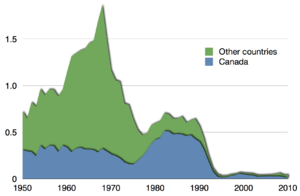
The collapse of the Atlantic northwest cod fishery in the 1990s changed everything. In 1992, the government stopped cod fishing because catches were falling fast. This decision had a huge impact on Newfoundland's economy. Many rural communities, once lively, saw people leave suddenly. The economic effect was compared to closing every factory in Ontario. The cod fishery, which had supported Newfoundlanders for over 200 years, was gone. The federal government helped fishermen and fish plant workers with a program called "The Atlantic Groundfish Strategy" (TAGS).
Tourism Growth
Starting in the 1990s, tourism was promoted as a way to rebuild the economy of many outports and villages. Government programs provided some short-term funding for tourism projects. This helped keep spirits up and find new economic roles.
Whale Hunting
Whale hunting became important around 1900. At first, men used harpoons from small boats. Then, new technology from Norway brought cannon-fired harpoons and steam-powered boats. This allowed hunters to target large, fast-swimming whales. The industry had busy periods in 1903–05, 1925–30, 1945–51, and 1966–72. After that, worldwide bans stopped it.
When Newfoundland joined Canada in 1949, it gave control of its fisheries to the federal government. In 1983, the Supreme Court ruled that the federal government also controlled offshore oil drilling.
Politics in the Mid- to Late-20th Century
Politics after the war had three main periods. Each period involved the decline of the traditional, stable, outport economy. Cities and industries grew.

The Liberal Party, led by Premier Joey Smallwood, controlled politics from 1949 until 1972. Smallwood's main goal was economic growth. He wanted to create new jobs to encourage young people to stay in Newfoundland. He worked hard to modernize fishing, create a new energy industry, and attract factories. He also improved education and transportation. Smallwood upgraded the small Memorial University College to Memorial University of Newfoundland (MUN) in 1949. It offered free tuition and money for students.
Smallwood's leadership style was very strong and personal. He completely controlled his party. Meanwhile, those who opposed joining Canada became the provincial branch of the Progressive Conservative Party. The Trans-Canada Highway was extended, becoming the first paved road across the island in 1966. That year, Smallwood's government advertised a "Come Home" program. It aimed to attract Newfoundlanders who had moved away, showing them the changes in the province's economy and infrastructure.
In 1972, the Smallwood government was replaced by the Progressive Conservative government led by Frank Moores. In 1979, Brian Peckford, another Progressive Conservative, became Premier. During this time, Newfoundland argued with the federal government over who controlled offshore oil resources. They eventually reached a compromise. In 1989, Clyde Wells and the Liberal Party returned to power, ending 17 years of Conservative rule.
The fishing crisis of the 1990s further weakened the economy of many towns. This was made worse by government programs that aimed to reduce the state's role in the economy. As the crisis hit, tourism was promoted as a way to rebuild the shattered economy of many communities.
In 1996, Brian Tobin, a former federal minister, became the leader of the provincial Liberal Party. Tobin benefited from good economic times as the province's economy shifted, mainly due to the oil and gas industry. He also benefited from the discovery of a large nickel deposit at Voisey's Bay, Labrador. Tobin promised to negotiate a better royalty deal for the province from mining companies. After Tobin returned to federal politics in 2000, the provincial Liberal Party struggled. Its new leader, Roger Grimes, became premier in a weaker position.
21st Century Developments
The oil and gas industry's desire to explore offshore in Atlantic Canada led to a dispute between Newfoundland and Nova Scotia. A federal court decided on a disputed offshore boundary in 2003. The settlement favored Newfoundland, opening the area for energy exploration.
In 2003, the federal government stopped the last remaining cod fishery in Atlantic Canada, in the Gulf of St. Lawrence. Newfoundland was again the most affected province. Premier Grimes, facing an election, used this decision to try to rally citizens. He called for a review of the Act of Union, which made the province part of Canada. On July 2, 2003, a report called for more cooperation between the province and Canada. It also called for better deals on the fishery, hydroelectric development, and offshore oil and gas.
In October 2003, the Liberals lost the provincial election to the Progressive Conservative Party, led by Danny Williams. In 2004, Premier Williams argued that Prime Minister Paul Martin had not kept his promises for a new deal on the "Atlantic Accord." The issue was oil royalties. The province wanted 100% of the royalties to help it escape poverty.
Towards the end of 2004, Williams ordered the Canadian flag to be removed from all provincial buildings. This was a protest against federal policies. The issue, called the "Flag Flap" in the media, caused much debate. The flags went back up in January 2005 after Paul Martin said he would not negotiate if the flags were not flying. At the end of January, the federal government signed a deal. It allowed 100% of oil revenues to go to the province. This meant an extra $2 billion over eight years for the province. However, this agreement led other provinces like Ontario and Quebec to seek their own special deals.
Newfoundland Identity
A strong feeling of being "Newfoundlander" has become powerful in the province's politics and culture. This identity was first seen in the 1840s, distinguishing between people born in England and those born in Newfoundland. The lack of a strong feeling of being an independent country was why Joey Smallwood won the referendum to join Canada. Most islanders were descendants of immigrants from Ireland or the West Country of England. It took centuries for them to see themselves as Newfoundlanders first.
By 1930, a unique Newfoundland song culture had developed. These songs showed that the island was still a mix of cultures. Some outports were completely Irish, others were West Country. In a few mixed communities, like St. John's, a local, patriotic song culture emerged. After joining Canada in 1949, Newfoundland culture changed significantly. The cultural revival of the 1970s celebrated the virtues of the people before modern changes. Today, the "Ode to Newfoundland" is sung with pride both on the island and by Newfoundlanders who have moved away.
Traditional Newfoundland heritage has seen a rebirth in arts and crafts. Celebrations of outport life are combined with a long-standing feeling of being unfairly treated. This includes blaming historical figures like fishing admirals for the province's struggles. Atlantic Canadians often share the view that their region is economically poorer and politically weaker than the rest of Canada.
Wayne Johnston's novel The Colony of Unrequited Dreams (1999) explores the unique identity of the islanders. It challenges common misunderstandings about the area. The main character is Premier Joey Smallwood, focusing on his support for joining Canada. The novel looks at themes of displacement, identity, and history.
See also


